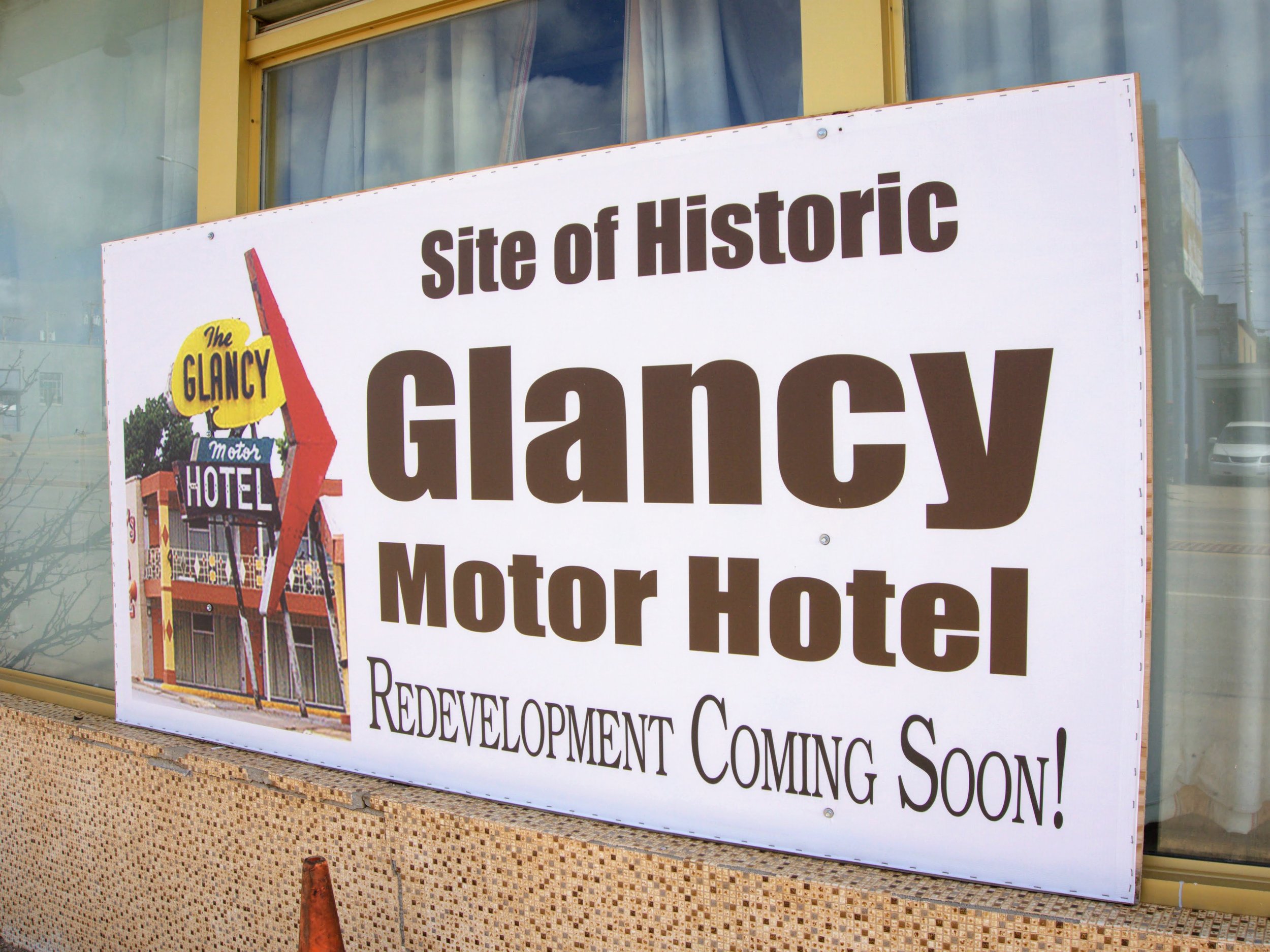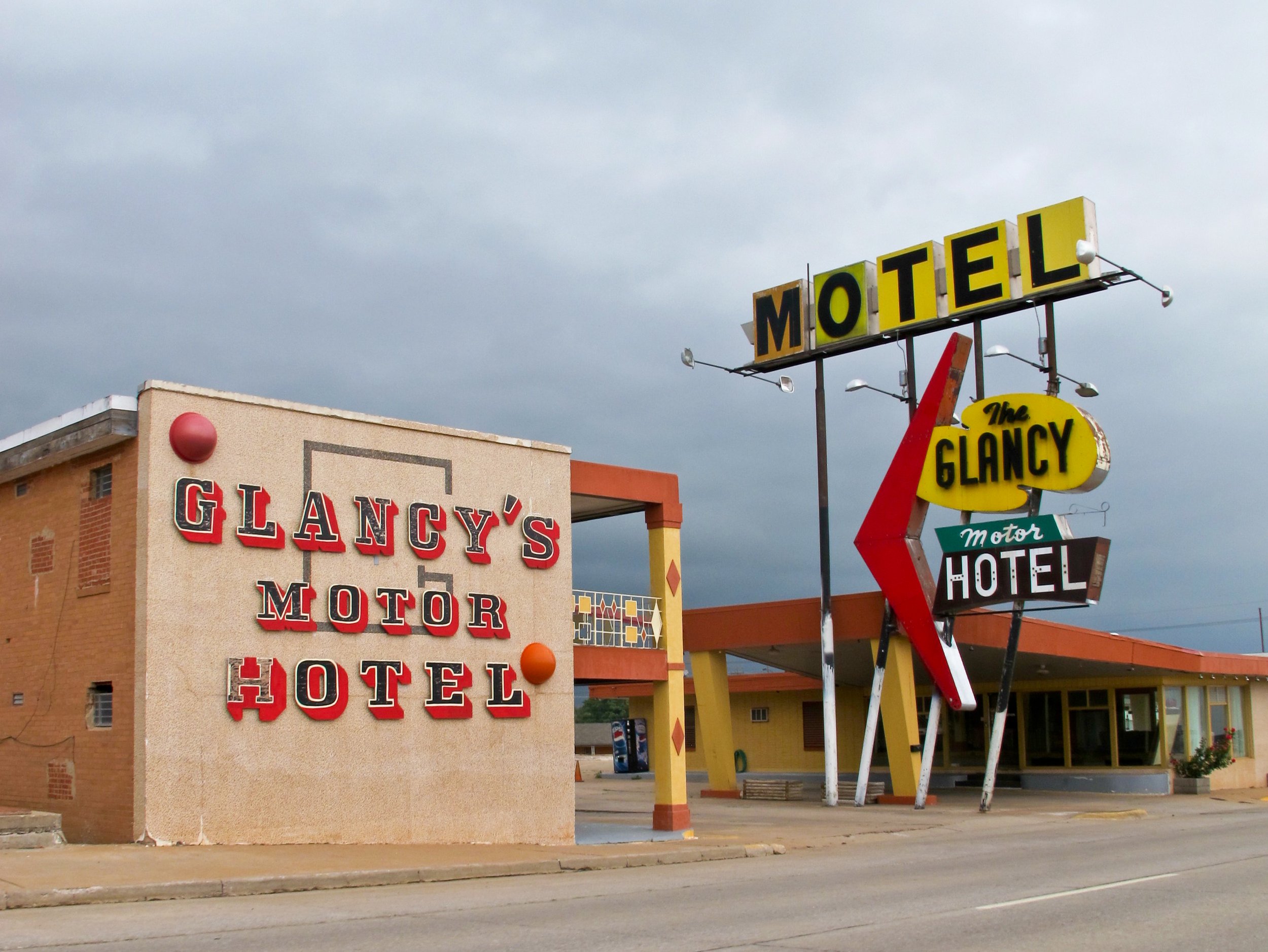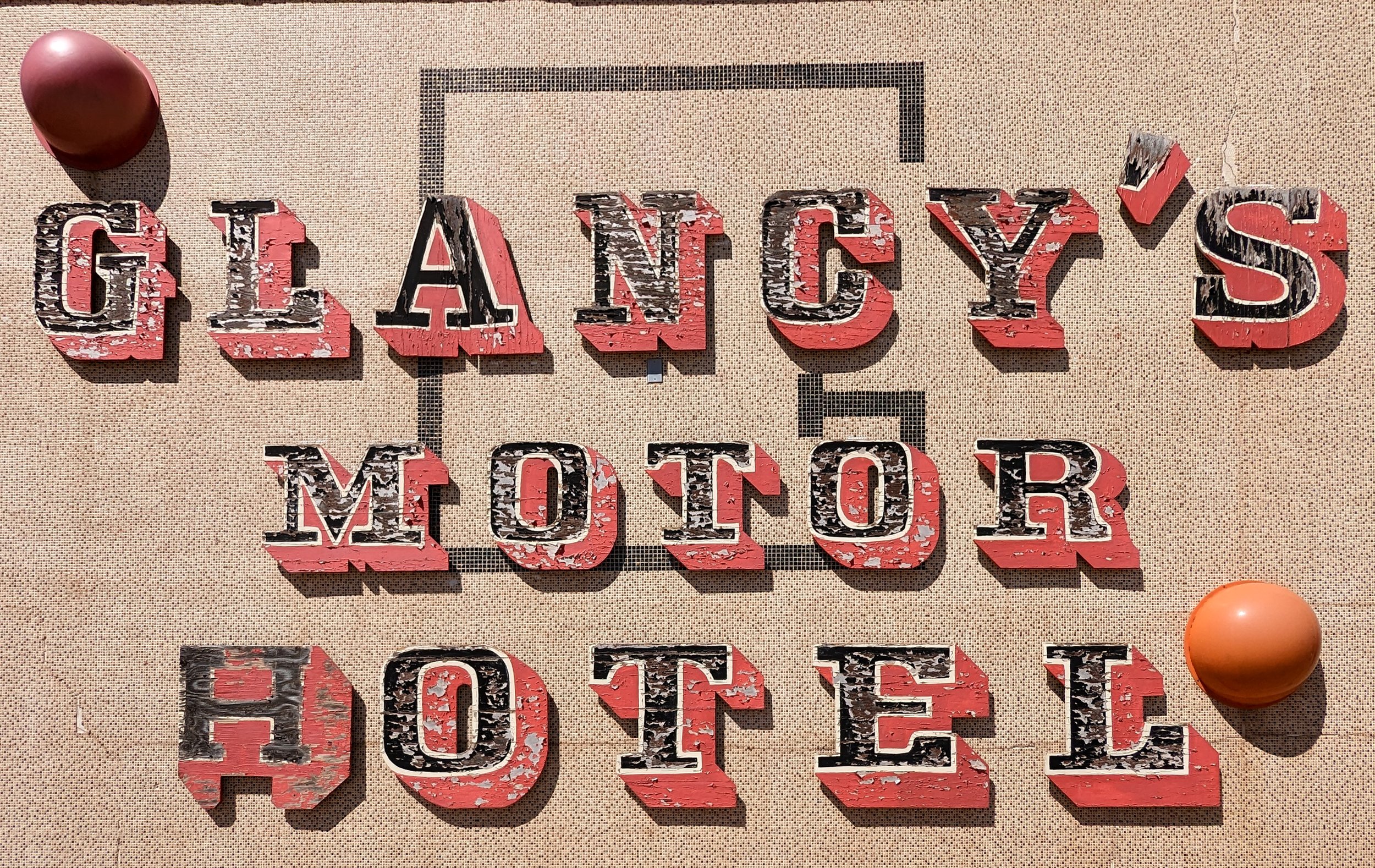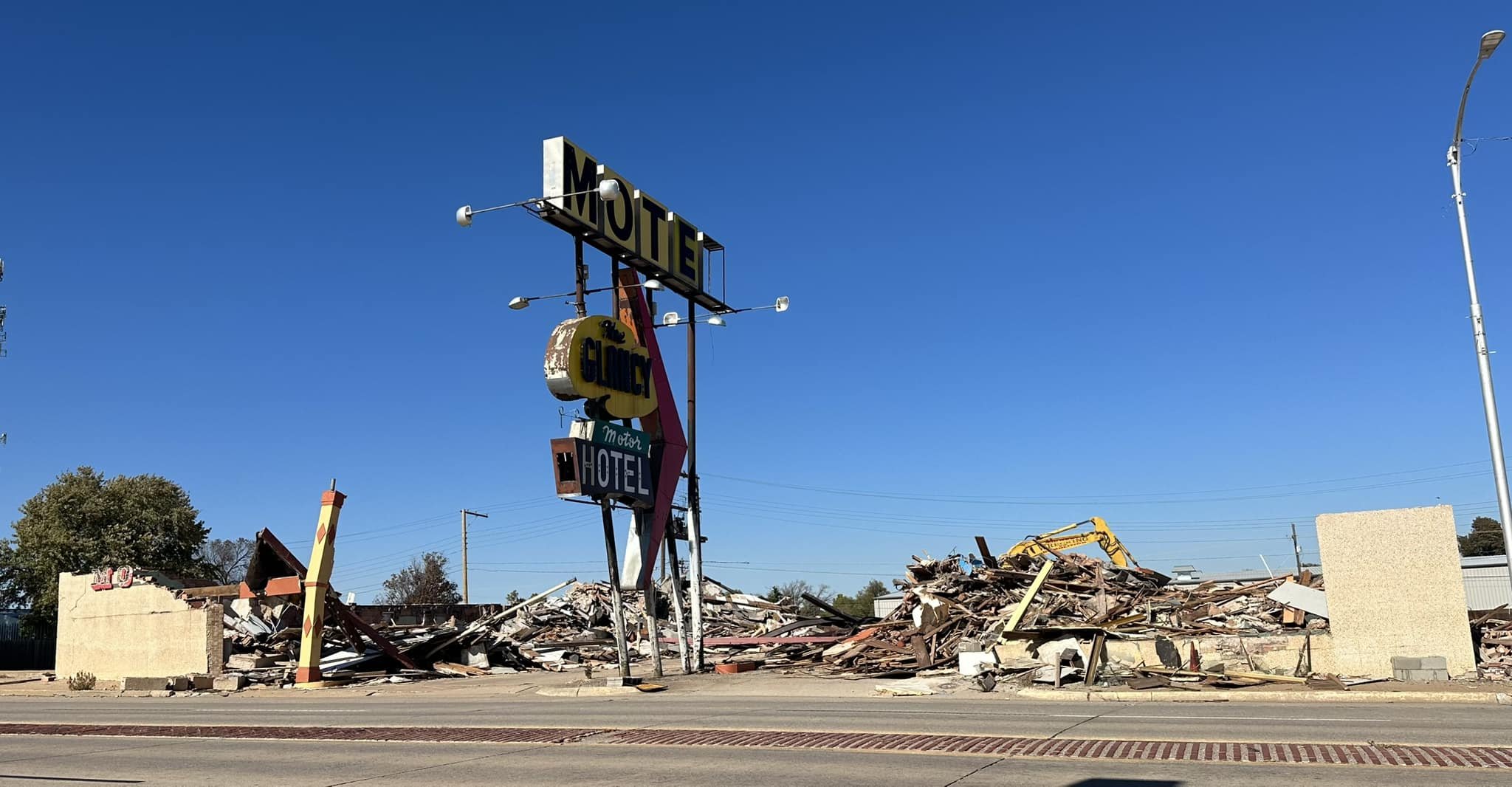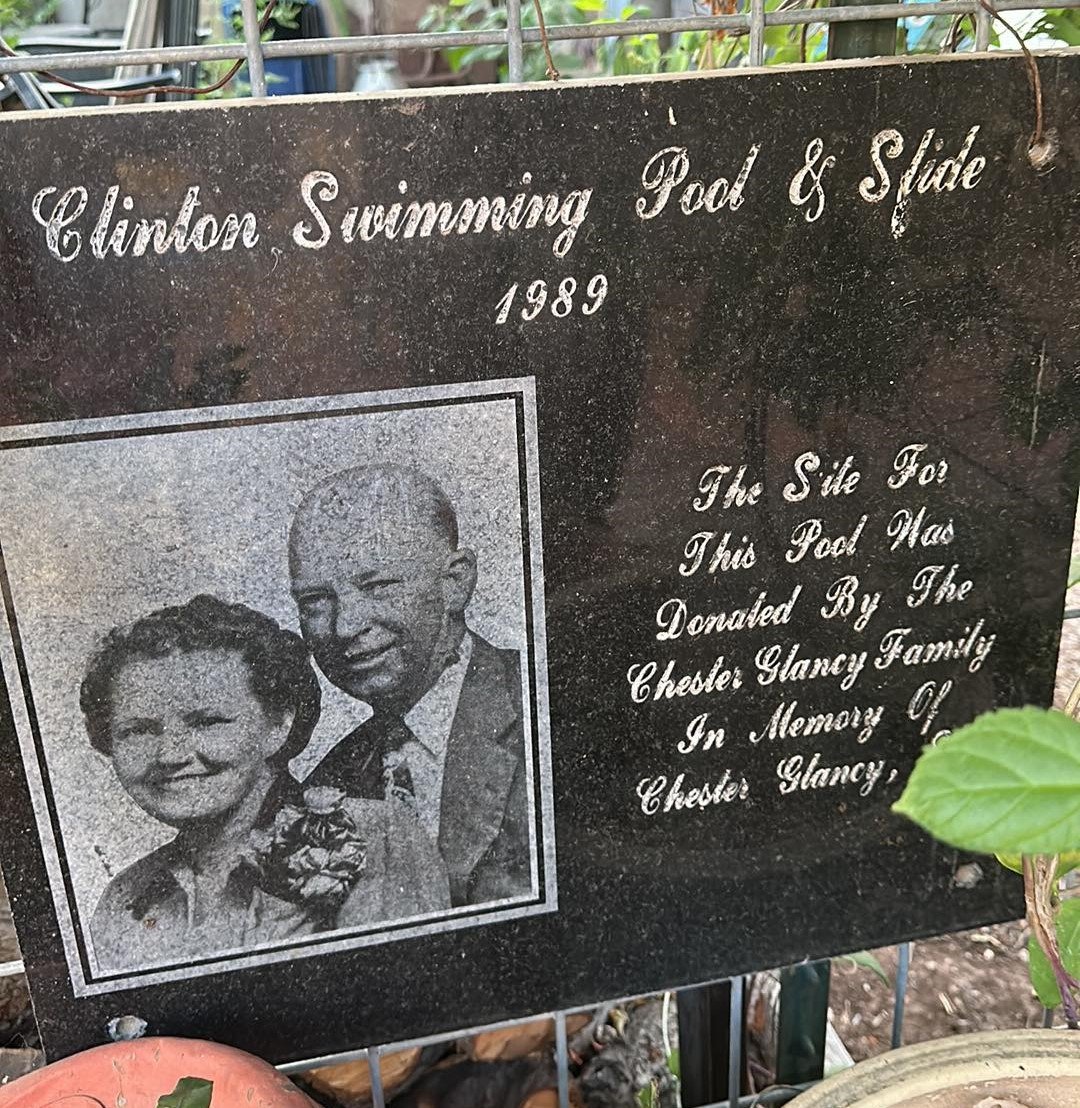The Glancy: Part Two - Dashed Hopes
by Rhys Martin
If you missed Part One, check it out here.
Chester Glancy passed away in 1977, several years after selling the Glancy Motor Hotel in Clinton. Gladys lived for another 24 years, watching as highway that had brought them such prosperity faded into obscurity…and then experienced a rebirth. Michael Wallis’ book Route 66: The Mother Road was released in 1990, signaling a new era for the highway and its history. “People in Clinton will not ever let go of their highway,” the text says as it guides the reader to Pop Hicks Restaurant, calling out Clinton as the long-time home of the US Highway 66 Association. A photo on Page 117 includes the iconic neon sign of the Glancy.
The road to revitalization is never a straight shot, however. Pop Hicks’ place was destroyed by fire in 1999; because the owners didn’t have it insured, the popular restaurant was not rebuilt. The Glancy Motor Hotel had seen better days by then but went through a remodel in the mid-2000s. Still, it wasn’t enough to stave off a continued slide to ill repute. A small bright spot: the motel was a filming location for the 2016 Lifetime movie “A Mother’s Escape” - though it didn’t boost any interest from the community. In 2019, after years of code violations and other problems, the Glancy Motel was officially condemned by the City Council. The greater Route 66 community feared the worst.
The Clinton Economic Development Authority (CEDA), a separate body of citizens established by the City, sent out a request for proposal hoping a developer would be interested in restoring the site. If a proposal was accepted, the City would purchase the property and work with the developer.
Rick Koch of ASAP Energy submitted a $7.7 million proposal to redevelop the Glancy, which also included rebuilding the lost Pop Hicks eatery next door. “There’s a lot of history there and we really want to push for the 100 the 100-year anniversary of Route 66 in 2026,” he told the Clinton Daily News at the time. “I feel like we have to work together to celebrate and use years ’22, ’23, ’24 and ’25 as ramp-up years.” CEDA accepted that proposal in August of 2021 and started getting the paperwork together.
A memorandum of understanding was signed and CEDA moved to purchase the property, which was divided into three parcels. As part of the redevelopment plan, the remaining foundation of Pop Hicks would be demolished and the motel rooms on the north side of the Glancy would be torn down. This would leave the office, the pool, and the 18 units closest to Route 66 with the rest of the area to be rebuilt.
The Glancy in 2014
“We are moving the project forward, and we continue to work with our selected development partner, Rick Koch,” CEDA Director Roland Mower told the Clinton Daily News at the time. “Everything we are currently proposing to do addresses health [and] safety issues. The City owns the properties now, and there’s liability attached to it in its current state. We are just moving the project a little bit further down the road so the community can see movement on the project, and we alleviate the City of some of the property’s liability.”
In late 2022, however, those redevelopment plans hit a snag and everything began unraveling. An ongoing dispute about the third parcel, an undeveloped strip of land in the same block, held up the full acquisition by the Development Authority. Rick Koch was unable to proceed with his plan and instead purchased the former Whitten Hotel along I-40, which is located near one of his Lucille’s Roadhouse restaurants.
Fading paint in early 2023
CEDA sent out another RFP seeking bids to redevelop the property, though some in the City were already losing patience with the process and didn’t see the value in a tourism-focused project with such a nuisance property. A local developer gave a presentation combining the 18-room building and office with a collection of Airstream trailers on the north parcel. An out-of-state developer proposed building apartments. These proposals had been submitted in the previous RFP request; no new developers stepped forward with a plan. The proposals were rejected due to lack of funding. However, there was a totally different idea that was gaining traction.
The Oklahoma Department of Public Safety needed a new headquarters. Their old building near the Oklahoma Route 66 Museum in Clinton was built in the 1960s and had been outgrown. DPS proposed using the Glancy site for a new facility, which would include an Oklahoma Highway Patrol Safety Center and an office for OSBI and the Oklahoma Bureau of Narcotics. State Representative Anthony Moore told the Clinton Daily News in early 2023, “We drove into town, and I showed them a few options, including the Glancy, though I made it clear I had no control over it and it was in the City’s possession. They all unanimously wanted the Glancy site because of its location in town and near I-40 and Highway 183.”
The north buildings of the Glancy, demolished in February of 2023
In February of 2023, the northern section of the motel was finally razed leaving the office, front rooms, sign, and pool. The Oklahoma Route 66 Association reached out to the City of Clinton at that time and was told that they were still trying to find a way to save what was left. For the City, options were dwindling and the threat of losing their long-time Highway Patrol hub loomed large.
On July 2, 2023, news broke that the Clinton Economic Development Authority had authorized the City Manager to seek bids for tearing down the remaining structures at the Glancy.
“The most recent development that quieted any talk of a comprehensive refurbishing of Glancy site was when the Department of Public Safety signaled their intent to build a new Patrol and law enforcement center,” said Mayor David Berrong in an email to the Association. “We have been working to maintain them in Clinton and their desired location was the Glancy property.”
Mayor Berrong said that the Clinton Economic Development Authority, the City of Clinton, and a prospective local refurbishing group all agreed that Clinton must accommodate the Oklahoma Department of Public Safety. Both Mayor Berrong and State Representative Anthony Moore had both indicated that they planned to save the iconic sign for later placement, potentially at the Oklahoma Route 66 Museum.
“I and other leaders in Clinton are positioned to discuss any and all ideas with you as we look toward and past the 66 Centennial in 2026,” the mayor told the Association as he acknowledged that there was no more that could be done.
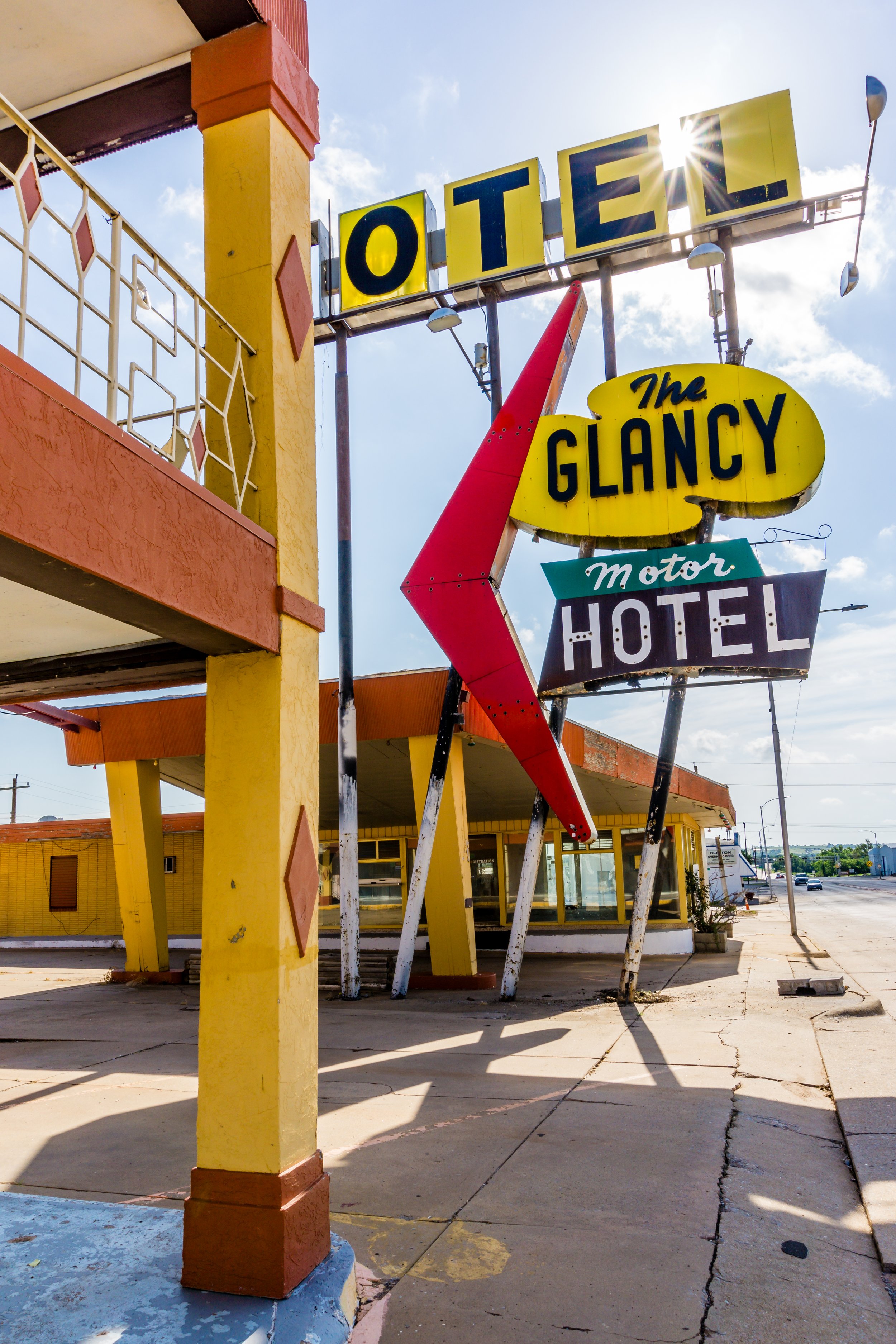
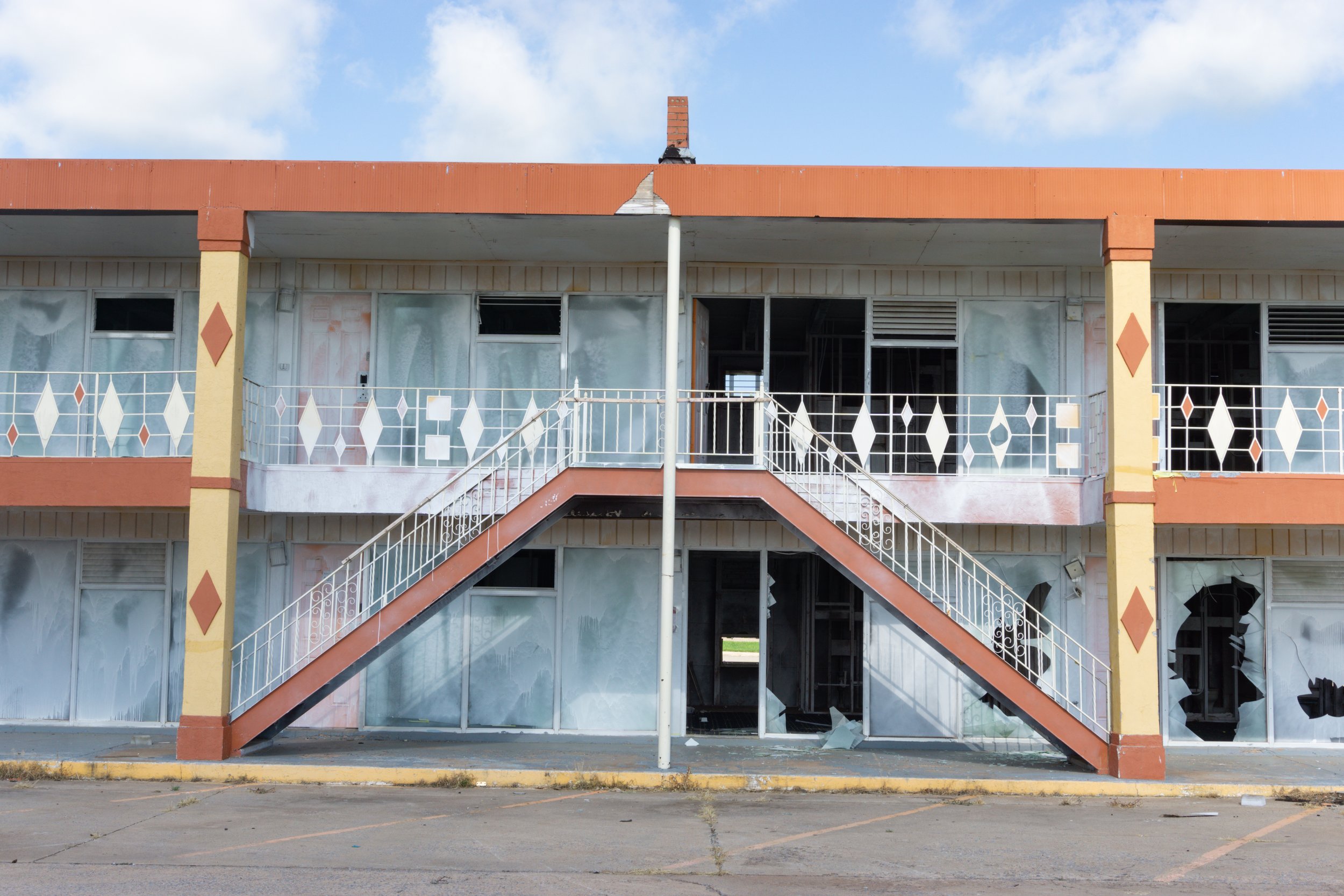
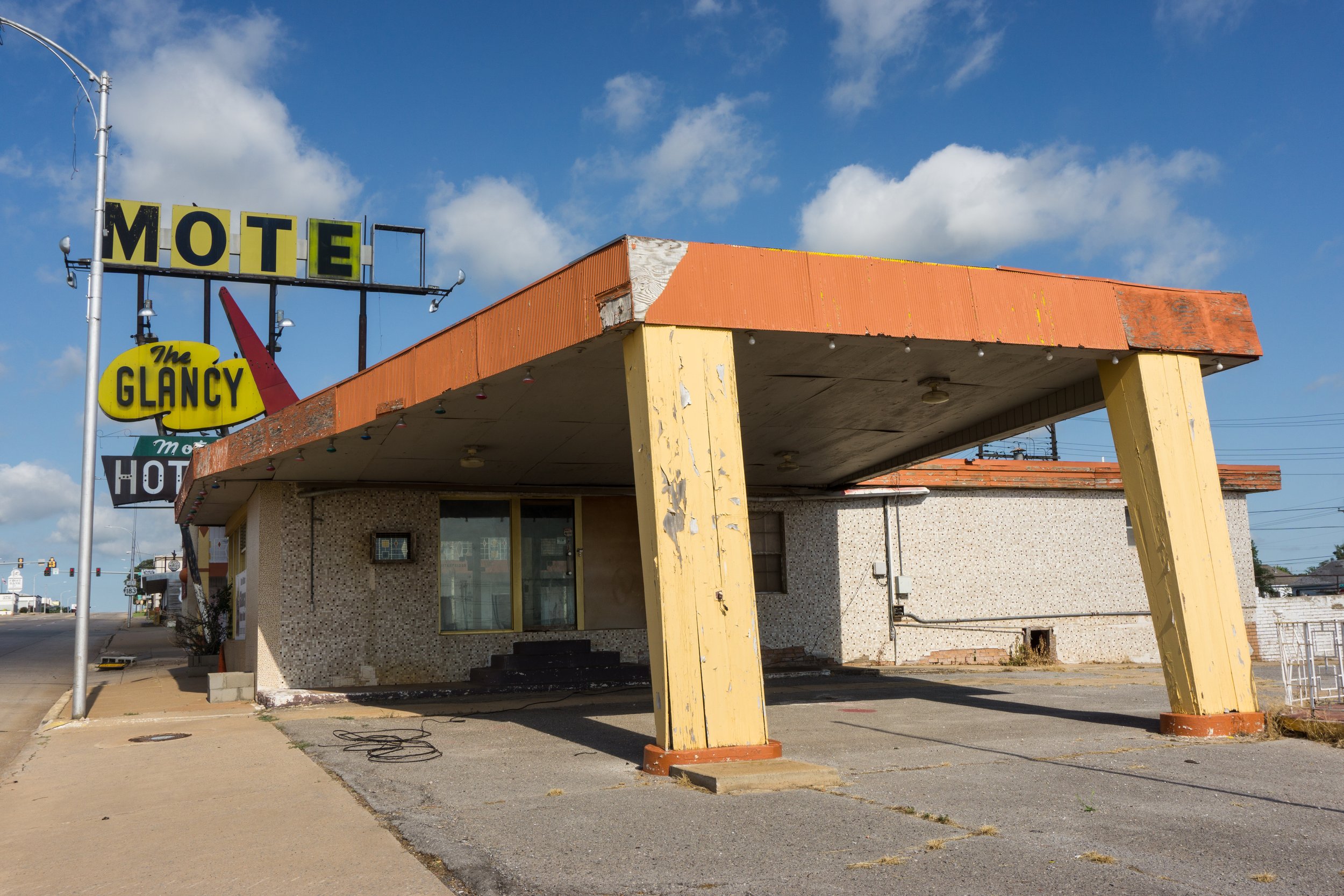
The Oklahoma Route 66 Association met with Mayor Berrong in mid-July in a last-ditch attempt to find a solution that would save the historic motel. Although the Mayor expressed disappointment in the fact that the demolition of the site was a, “done deal,” he outlined the circumstances that led CEDA to this decision. A land dispute, lack of developer interest, and that the Powers That Be were just ready to be done with a property that had been a blight for more than a decade. He also called out the concern that Clinton may otherwise lose their Oklahoma Highway Patrol headquarters and the jobs attached to it. And, since CEDA was a separate authority, they had the final say.
A visit to the old motel on July 18th, 2023 exposed the barren, stripped nature of what was left. Many of the windows were broken out. Interior walls of the rooms were reduced to studs. Tile on the outside of the building was crumbling and missing. The last residents of the roadside lodge looked down from their nests, chirping with curiosity. It was a sad reminder that preservation is an ongoing journey and it takes many partners moving in the same direction to achieve success.
In the last week of July, CEDA met to discuss bids for demolition. One trustee raised a concern about the finality of demolition and a local resident worried that other sites for the Department of Public Safety development hadn’t been considered, needlessly destroying one of Clinton’s remaining Route 66 landmarks. The Clinton Economic Development Authority voted 4-1 to accept a demolition bid, with the dissenting vote voicing concern that the City of Clinton wasn’t getting enough financial compensation out of the situation.
On August 1st, Clinton’s City Council met to review CEDA’s recommendation to accept the demolition proposal. The Oklahoma Route 66 Association had several representatives in attendance and were joined by Preservation Oklahoma. Along with an official Association statement, the National Park Service joined our plea to find a solution that did not involve demolition. Frustratingly, the bid was accepted as part of a consent agenda, bundling multiple items together to pass without discussion. Our statement, which we had expected to give before the decision was made, was still read to the City Council in full. It is as follows:
To the Clinton City Council:
The Oklahoma Route 66 Association has been working to preserve and promote Historic Route 66 in the state for over 30 years. Time after time, we have seen communities remove historic assets that contribute to the unique American story that is Route 66. Clinton, Oklahoma is already known internationally for the Route 66 Museum, cited often as a favorite attraction not just in Oklahoma but between Chicago and Santa Monica as a whole. The demolition of the Glancy Motor Hotel represents a loss not just for Clinton, but for Oklahoma and all of Route 66.
Oklahoma suffers from a lack of authentic historic lodging along Historic Route 66. When development plans were announced to renovate and restore the Glancy, we were overjoyed. Rather than push on to Texas, Route 66 travelers would have a place in western Oklahoma to stay overnight in accommodation that provides the experience that thousands of travelers seek when they decide to explore America via its most famous road. However, that excitement turned to despair as plans stalled and news broke that the City of Clinton would rather donate the land to the State rather than continue the pursuit of preservation for this one-of-a-kind landmark.
The Association shouldn’t have to tell you what a positive economic engine Route 66 is for the communities that capitalize on its brand. According to the office of Lt. Governor Matt Pinnell, every dollar invested in tourism in Oklahoma returns seven-fold. 2021 was the best year for Oklahoma Tourism in state history, generating over $10 billion in direct visitor spending. Route 66 advertising, specifically, had a 259:1 return on investment that year. Rutgers University has released multiple studies showing the world-wide recognition that Route 66 has and how towns, big and small, see increased tourist spending when the identity of the highway is embraced. By demolishing this property, Clinton is robbing itself of these dollars.
The Centennial of Route 66 is right around the corner. When people from around the world come to Clinton in 2026, we fear they will come through Clinton. Every one of Oklahoma’s Route 66 communities has a unique story to tell; we sincerely hope that Clinton’s story will not have to include missed opportunities and the loss of history that makes Route 66 such a special place.
Alas, minds had been made up. It took a little white to cross the t’s and dot the i’s but afterwards the writing was literally on the wall. Some locals lamented the loss, while others rejoiced in the removal of what they saw as a useless, nuisance property. “The citizens of Clinton that love the Glancy want it to be restored,” said one person. “But, like a family does sometimes, when someone is on life support and sees a family member not getting any better…it’s just time.” The last of the Glancy came down on November 7th, 2023.
Image courtesy of the Discover Clinton, Oklahoma Facebook page
The City of Clinton invested about $500,000 in a project that had been a dream for the Route 66 family, injecting hope and excitement into a bright future for the Oklahoma landmark. Those hopes diminished as local disputes and conflicting priorities caused delay after delay, eventually resulting in an unwinnable scenario. Delay demolition of a dilapidated property with an uncertain future or use the land to satisfy a long-time local employer, keeping them in the community? Unfortunately for us all, the Glancy lost.
Plaque honoring the Glancys and their donation of land for the City Pool. Photo courtesy of Kimberly Glancy Johnson.
Although The Glancy Motor Inn is gone, the legacy of Chester and Gladys isn’t gone with it. The municipal pool on the north side of McLain Rogers Park is on land that the Glancys donated to the City of Clinton. The City of Clinton maintains that it wants to save the iconic sign and relight it, potentially at the Oklahoma Route 66 Museum. Representative Moore has stated he’d like to see a historic marker of some kind incorporated into the new Highway Patrol building.
Another way we in the Route 66 community can honor the Glancys is by continuing our quest for preservation, all of us. Look at your community; there are undoubtedly stories that need to be told that aren’t getting the attention they deserve. Today we grieve for what might have been, but tomorrow we continue the fight for what comes next.
Last residents at the Glancy
Credit to Route 66 News for tracking this story through a paywall, multiple local residents for keeping us in the loop, and our Association members for their advocacy.

